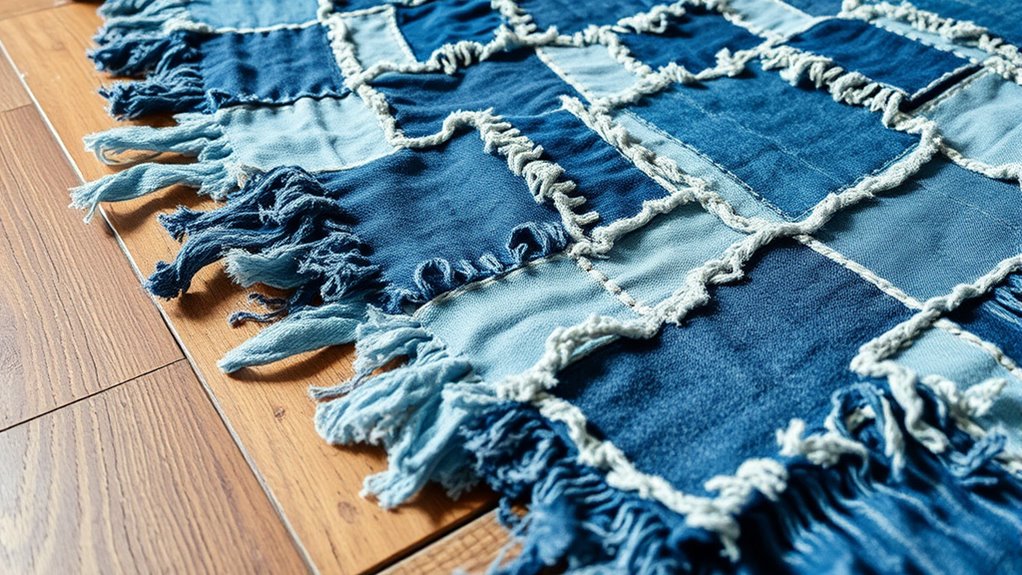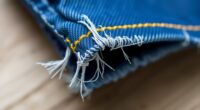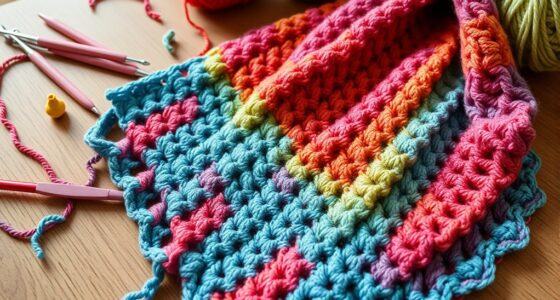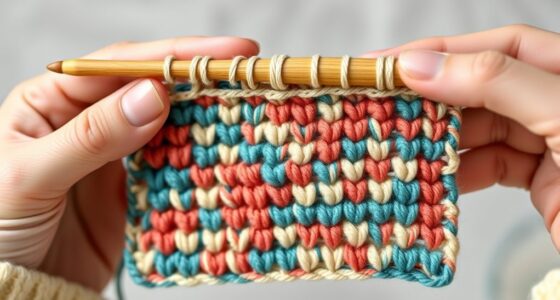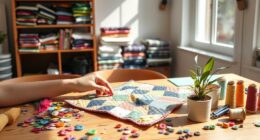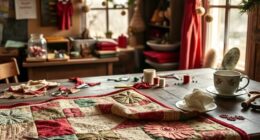Making a denim rag rug from old jeans is a simple, eco-friendly way to reduce waste and add a unique touch to your home. By cutting worn jeans into strips and weaving or braiding them, you turn discarded textiles into a cozy, durable decor piece. This project supports sustainable living and minimizes landfill contributions. If you want to discover more about turning waste into style, keep exploring how to craft your own denim rag rug.
Key Takeaways
- Creating denim rag rugs repurposes old jeans, reducing textile waste and supporting sustainable living.
- The project encourages upcycling, turning worn-out denim into functional, eco-friendly home decor items.
- Using simple weaving or braiding techniques emphasizes mindful consumption and waste reduction at home.
- Customizable designs promote eco-conscious choices while adding unique, sustainable decor to any space.
- This DIY approach aligns with zero waste principles, minimizing landfill contribution through creative reuse.
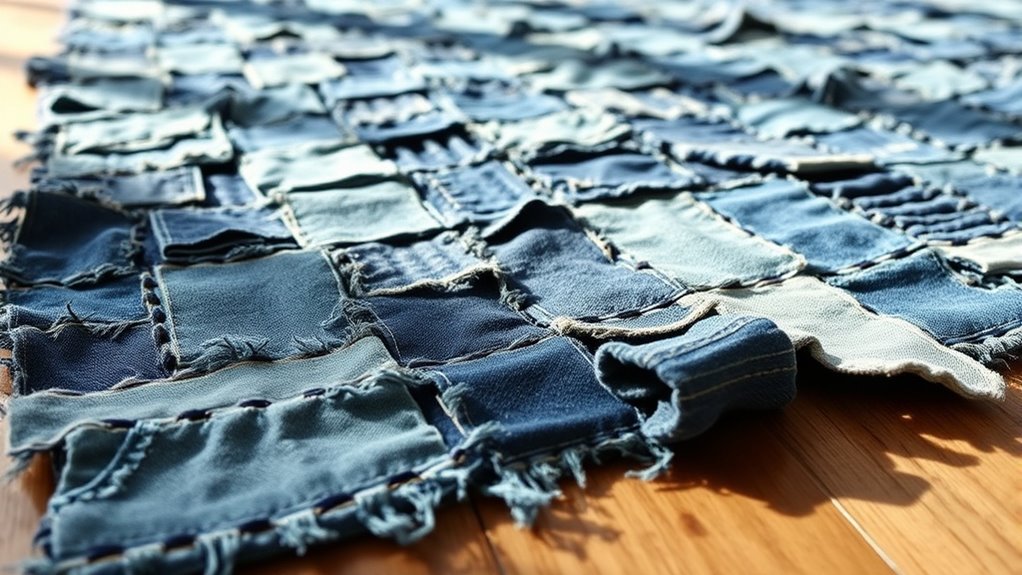
Have you ever considered turning old jeans into a stylish and functional piece of home decor? Creating a denim rag rug is an excellent way to breathe new life into worn-out denim while embracing upcycling techniques that support sustainable fashion. Instead of tossing those faded jeans or ripped pairs, you can transform them into a cozy, durable rug that adds character to any room. This project not only helps reduce waste but also allows you to showcase your creativity and commitment to eco-friendly living.
Transform old jeans into a cozy, stylish rug—upcycling waste into functional home decor.
To start, gather your old jeans—look for pairs that have sentimental value or are beyond repair. You’ll want to cut them into strips, which is the core of upcycling techniques used here. Using sharp scissors, cut along the seams to create long, continuous strips of denim. You can vary the widths, but generally, 1-2 inches works well. The goal is to have enough strips to weave or braid into a sturdy rug. This process exemplifies sustainable fashion by repurposing materials that would otherwise end up in the landfill, giving them a second life as a functional home accessory.
Once you have your strips, you can choose your weaving method. A simple braid or a more intricate weaving pattern works beautifully for a denim rag rug. Braid three strips together, then coil the braid into a circle or oval, sewing or pinning the ends together as you go. Alternatively, you can weave strips through a sturdy grid or frame, creating a more textured appearance. Whichever method you select, the key is to be patient and consistent, ensuring your rug is both attractive and durable. This hands-on process embodies the essence of sustainable fashion, turning discarded textiles into something useful and stylish.
Not only does making a denim rag rug give you a unique piece of home decor, but it also encourages a mindful approach to consumption. Each step—cutting, braiding, weaving—serves as a reminder that waste can be transformed into something beautiful and practical. Plus, it’s a project that can be customized to match your decor style, whether you prefer a rustic, boho vibe or a more polished look. As you work, think of the environmental impact you’re making by choosing upcycling over buying new. Your denim rag rug becomes more than just a decoration; it’s a statement of sustainable fashion and a small but meaningful step toward zero waste at home.
In addition, understanding the role of color accuracy in project creation can help you select denim with consistent hues, making your rug more visually appealing.
Frequently Asked Questions
Can Denim Rag Rugs Be Washed Regularly Without Damage?
Washing your denim rag rug regularly won’t damage it if you follow proper maintenance tips. To guarantee washing durability, use cold water and a gentle cycle to prevent fading and wear. Avoid harsh detergents and skip the bleach. Air dry or tumble dry on low heat to keep the rug in good shape. With proper care, your denim rag rug stays vibrant and durable, making it a sustainable addition to your home.
What Tools Are Necessary to Make a Denim Rag Rug?
To make a denim rag rug, you’ll need a few essential tools. Fabric scissors are vital for cutting denim pieces cleanly and accurately. A sewing needle helps you stitch the strips together securely. You might also want a sewing machine for faster assembly, but hand sewing with a needle works too. These tools guarantee your denim rag rug is sturdy and well-made, making it a rewarding zero-waste project.
How Long Does It Take to Complete a Denim Rag Rug?
The rag rug duration varies depending on your crafting timeline and the rug’s size. If you’re working steadily, it might take a few weekends or about 10-15 hours of dedicated effort. Keep in mind, larger or more intricate designs extend the crafting timeline. Your pace, experience, and rug complexity all influence how long it takes. Patience guarantees a beautiful, eco-friendly finished piece you’ll be proud of.
Are Denim Rag Rugs Suitable for Outdoor Use?
Imagine you’re setting up a cozy outdoor patio. Denim rag rugs can add charm, but their outdoor durability depends on weather resistance. While they’re great indoors, denim rugs aren’t typically designed for prolonged outdoor use, especially where rain or sun exposure occurs. Without proper treatment, they may fade or wear quickly. To guarantee longevity outdoors, look for denim rugs specifically crafted with weather-resistant finishes or consider sealing them.
How Can I Prevent Fraying in My Denim Rag Rug?
To prevent fraying in your denim rag rug, focus on proper edge finishing and fabric stabilization. You can sew a tight zigzag or serge along the edges to secure the fibers. Applying a fabric sealant or fray check can also help, especially for raw edges. These techniques reinforce your rug’s edges, making it more durable and resistant to fraying over time, ensuring your rug stays intact and looks great longer.
Conclusion
Imagine your old denim scraps transforming into a vibrant, sturdy rug—like a phoenix rising from the ashes. Each stitch you sew is a step closer to a greener home, turning waste into warmth and style. Your effort is the brushstroke in a larger masterpiece of sustainability, where every rag becomes a part of something beautiful and useful. So, keep weaving, keep repurposing, and watch your home bloom with the spirit of zero waste.
